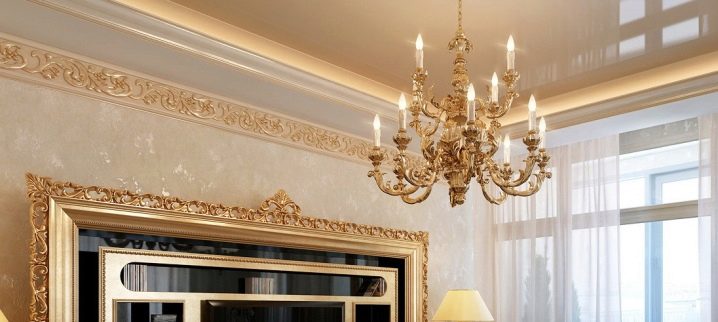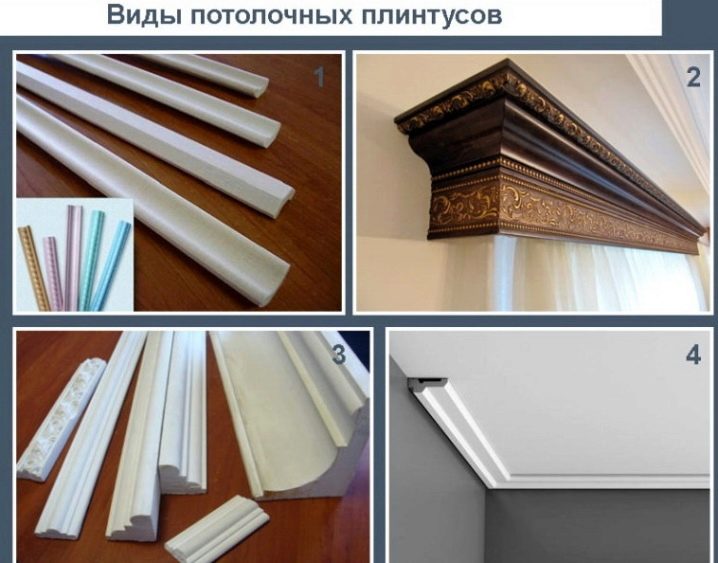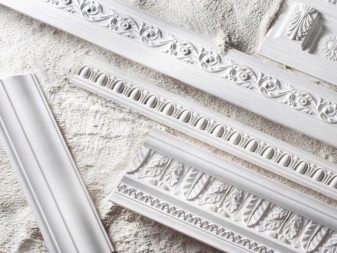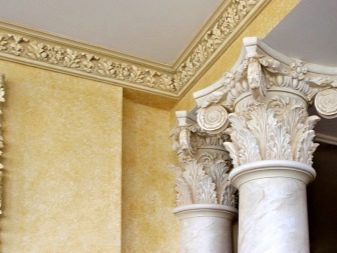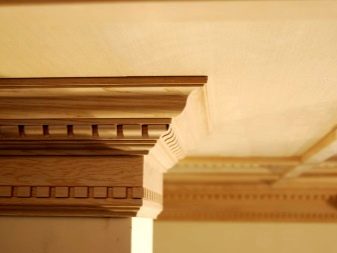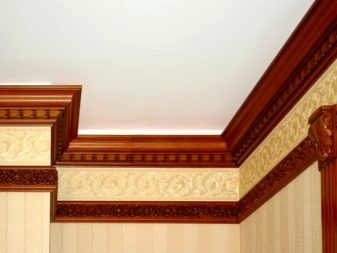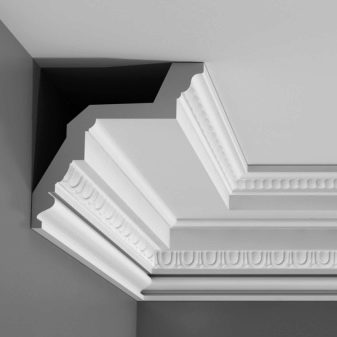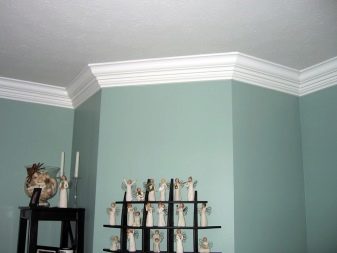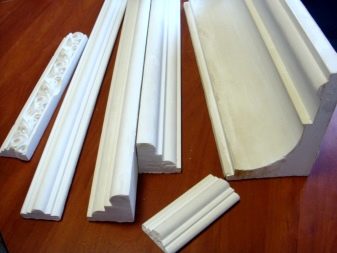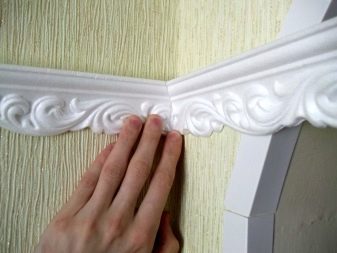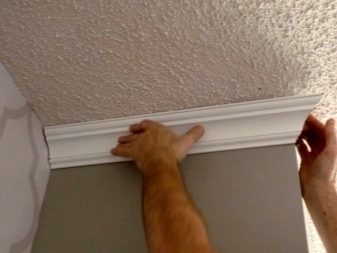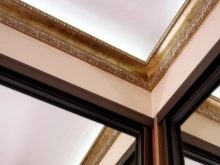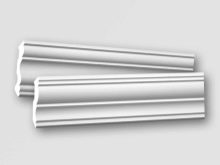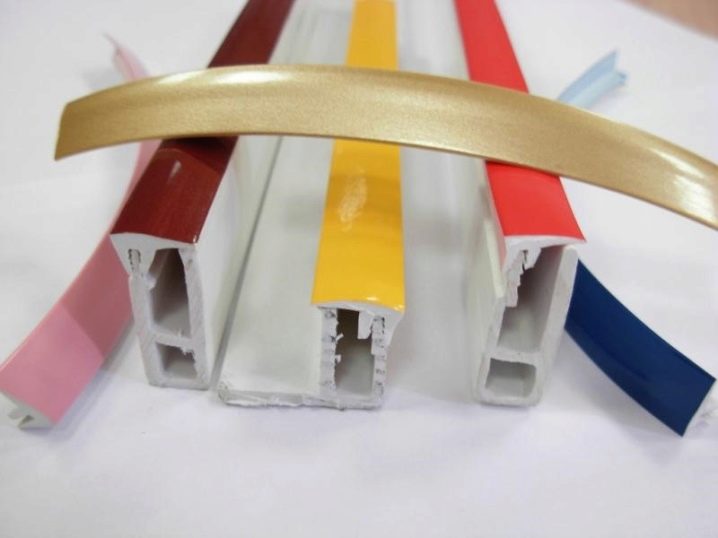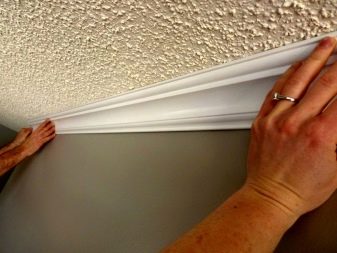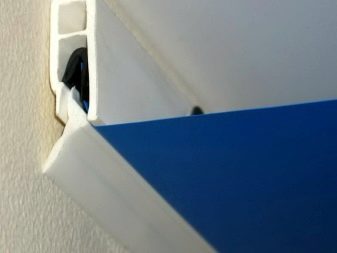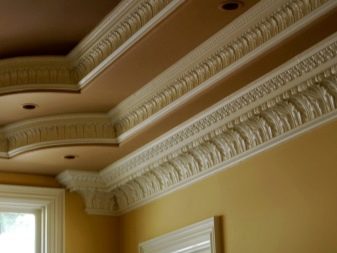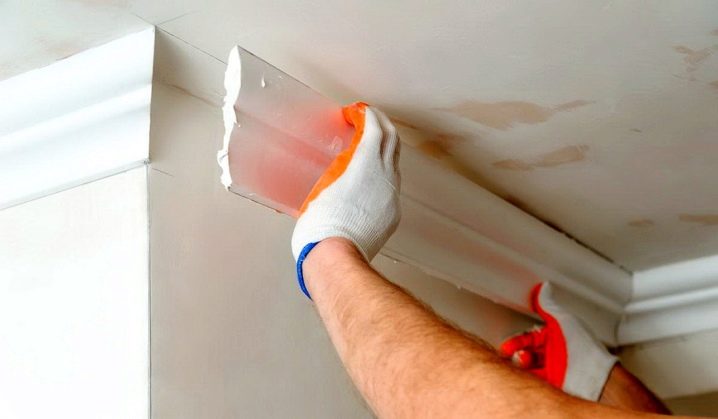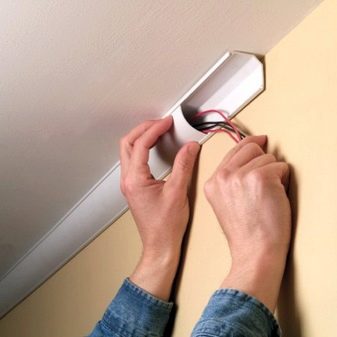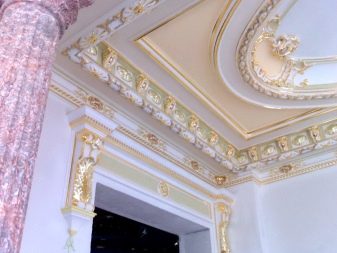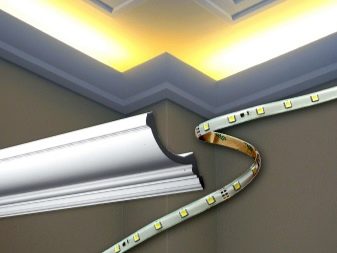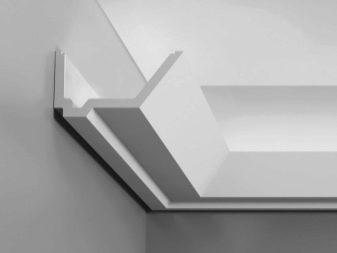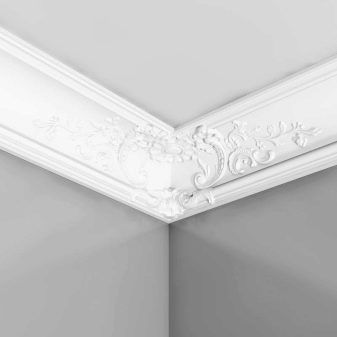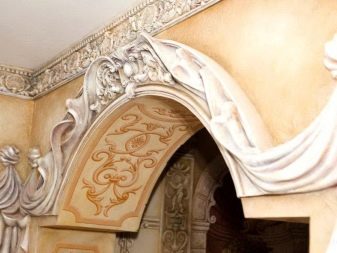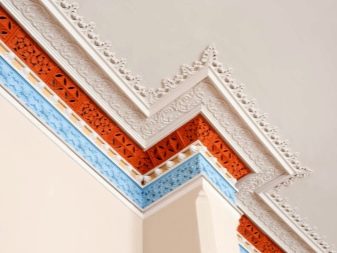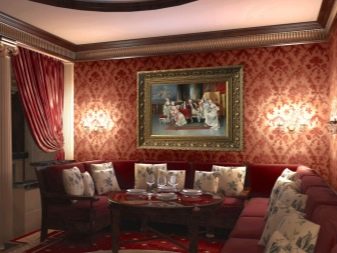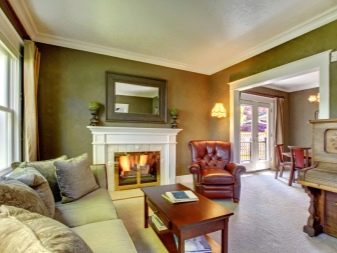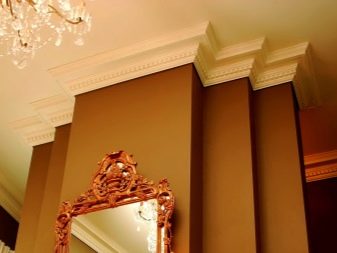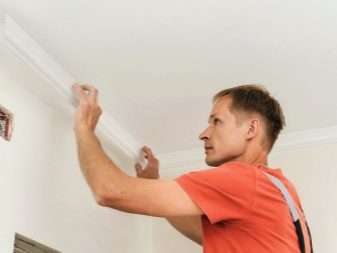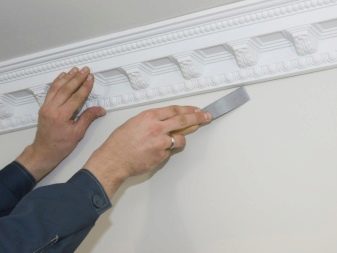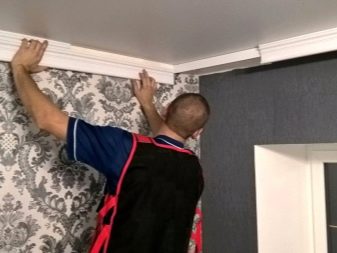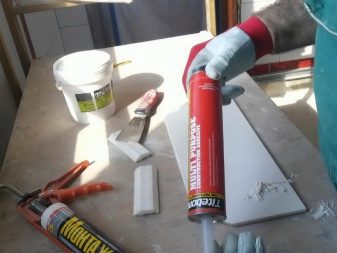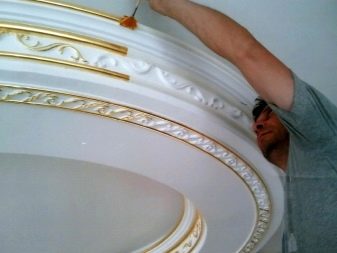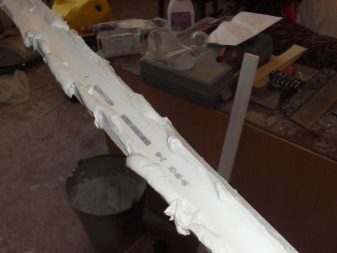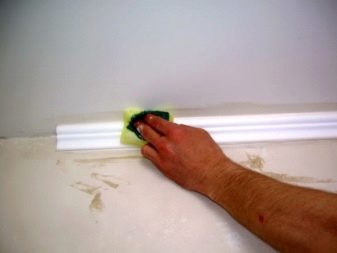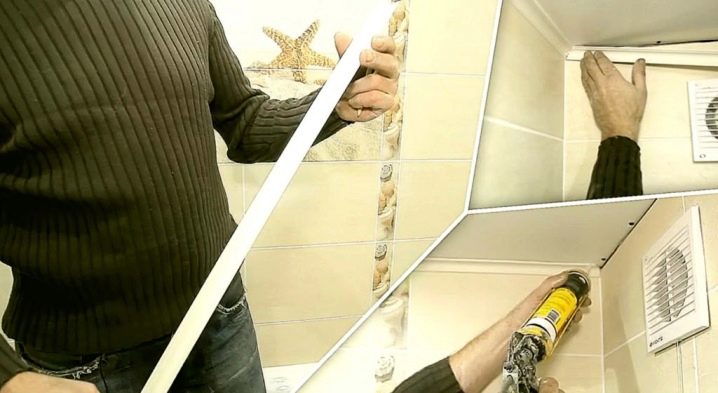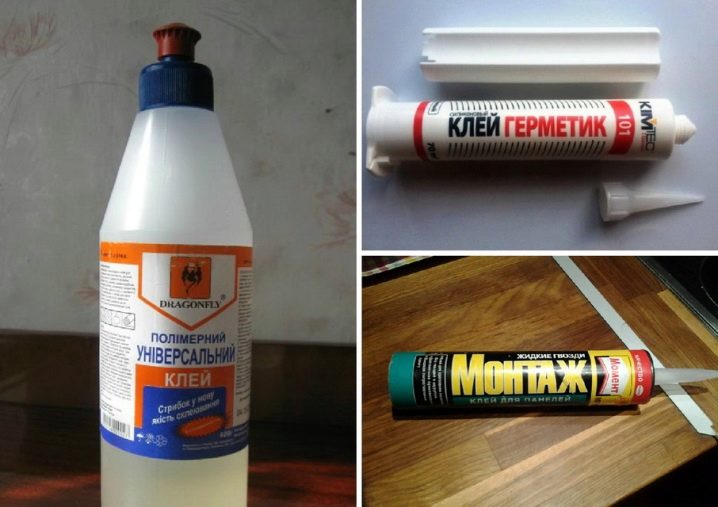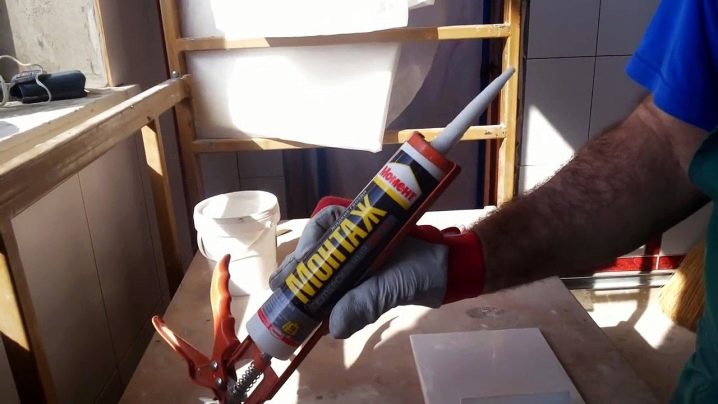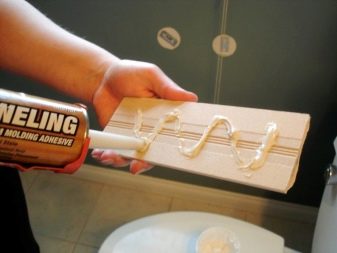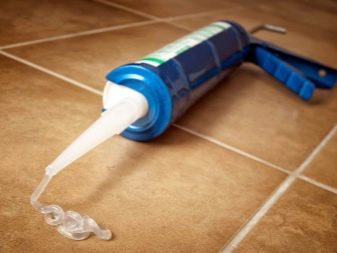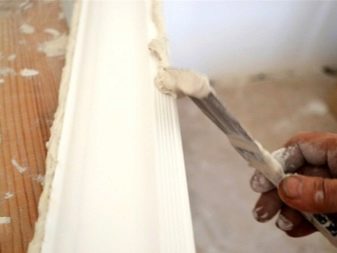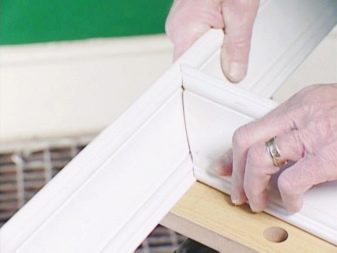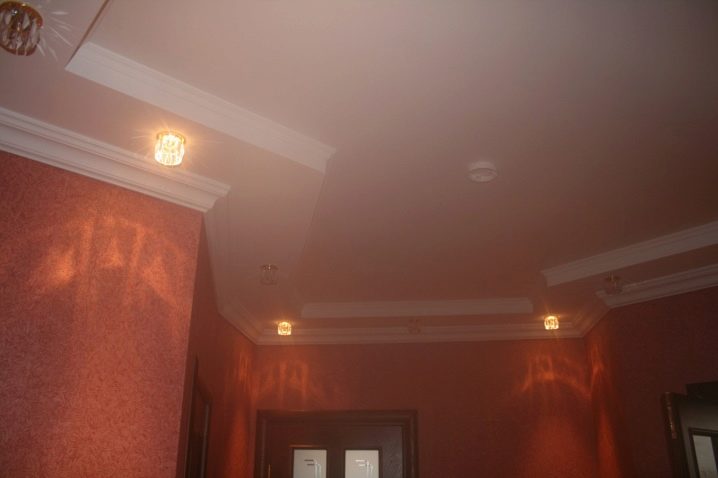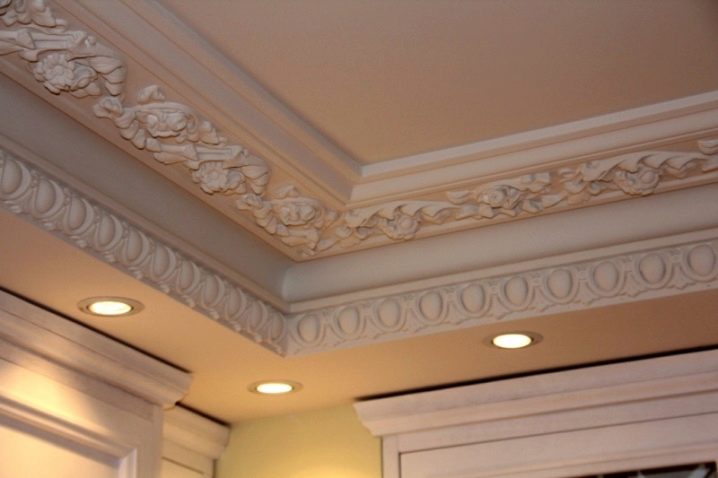The subtleties of the choice of plinth on the ceiling
The final stage of repair work in a residential area is completed with the installation of plinths. This material has other names: fillet, cornice, baguette. Previously, instead of baseboards, people used a paper panel. It was glued to the upper edge of the wallpaper and thus created a visual border between the ceiling and the wall.
The panel did not hide the irregularities and defects of the ceiling, and sometimes even highlighted some shortcomings. With the advent of beautiful skirtings, the design of the room has become more aesthetic and original. Baguettes easily eliminate any flaws after the completion of repair and construction works.
Special features
A huge number of types and varieties of baseboards allows you to create a unique design in the interior of a private house or apartment.Eaves for ceilings are classified according to the type of material produced, texture and width.
The following materials are used in the construction area for the manufacture of ceiling moldings:
- Gypsum. Gypsum-based curtain rods are rarely used as decoration for the ceiling. By virtue of its expensive cost, such baguettes are found in large mansions and cottages. They are used in architectural buildings related to historical monuments.
You should not forget that the plaster plinth is fragile material and rather bulky. Therefore, its further installation in the room should be performed by an experienced technician.
- Tree. Baguette made of natural wood, perfectly fit into the classic style of the interior with additional decorative elements. Usually, wooden fillets are used to decorate walls of dark and brown tones, as well as under high sideboards on the ceiling.
Experienced specialists and designers recommend installing fillets on a wooden base, along with classic furniture. Stopping on the choice of wooden eaves, special attention should be paid to the presence of ultraviolet treatment.Since this is an important detail, it is possible to minimize the impact of the environment on wood and prolong its operational period.
- Polyurethane. Most of these eaves are preferred by fans of antique decor. Because baguettes are similar in appearance to ordinary stucco. Using such a design, special attention should be paid even to small nuances, such as decorative elements.
Regardless of the high cost of material, experienced craftsmen prefer to use polyurethane curtain rods. Because they take any form without any further damage. Skirting can also be installed in the bathroom, as they are moisture resistant. Polyurethane baguettes are used for kitchen ceilings.
This material does not absorb individual flavors and goes well with various elements of the interior. Polyurethane-based baseboards are lightweight in weight. Therefore, they can be used for tensioning surfaces. It should be noted that the cornices are painted in any colors, perfectly preserve their shape and are easy to install.
- Polyfoam and polystyrene. Such materials have a large variety of shapes and colors.Baguettes on polystyrene or foam base are often installed on ceilings. Since these materials are of low cost, they are moisture resistant and are not susceptible to rotting and any effects of organisms that cause fungal growths. The main disadvantages are quite thin material and change their shade under the influence of lighting.
- PVC or plastic. Plastic-based fillets are the most common species. Cheap material, a variety of shapes, shades and textures allow the use of plinths in any interior. PVC baguettes are lightweight, resistant to any effects, as well as moisture resistant and durable. Plastic eaves are created already painted. Everyone will be able to choose the necessary color based on the interior design in the room.
- Baguettes or plinths are also usually classified by textural parameters:
- injection - made with thread;
- laminated - have a flat surface;
- extruded - with ready grooves.
Criterias of choice
Making a choice in favor of those or other baseboards, special attention should be paid to the material, color and shape.The important role played by the type of ceiling, namely the material used for its manufacture.
When it comes to tensioning surfaces, baguettes are mounted to eliminate any defects and gaps associated with the wall. However, it is strictly prohibited to glue the material on the ceiling structure.
Particular attention is paid to such nuances:
- Total weight The lightest materials - expanded polystyrene, plastic, foam - are glued directly to the wall, since they are practically not deformed. The adhesive used for installation must be high strength and reliable. It is better to trust the experienced brands, rather than redoing work again.
- The junction to the surface must be sufficiently flat so that gaps do not remain.
- Plastic baguettes perfectly mask any joints of the ceiling and walls. Small roughness will be almost imperceptible.
- Wooden products can be installed only with special fasteners for the wall.
- Galteli perfectly hide the extra gaps between the ceiling and the wall.
For mounted structures made of drywall, you can use almost any model.Therefore, as the main attachment to the ceiling structure is performed on both sides. Polystyrene or polyurethane foam moldings look great on hanging structures.
The main side of the junction to the surface, contributes to the visual increase in the height of the room. Illuminated eaves and wooden baseboards, can also be used on hanging surfaces.
- If you touch plastered ceilings, then it is worth highlighting the main details and nuances of this process. Usually, even a perfectly smooth surface may have small flaws and irregularities after plastering. Therefore, the choice should be made in favor of baguettes with soft edges - foam or polyurethane.
I also recommend installing plaster based plaster on a plastered surface. A similar option can be stucco, which occupies a special place in the interior decoration.
- For mounting eaves on a plastered surface, it is best to use material with a finished cable channel, allowing you to hide any wiring without additional crushing of walls.
Kinds
Baguette profiles for fillets can be created from various components.In addition, they may vary in width and shape. Most often, the length of the baguette does not exceed 2 m.
Polyurethane baseboards can be imitated with stucco:
- solid baguettes made of polyurethane, decorated with decor and beads;
- fillets with cut-out holes for the lighting system, neon tubes are also used.
Also, it is necessary to allocate certain types of eaves on a polyurethane basis.
The original fillet backlit for the ceiling. Such borders are called diode. This is a unique trend in the world of interior design. Such materials are used in rooms with a main source of lighting and additional spotlights, lamps. Diode lamps are perfectly combined with the baguette due to the cutout on the surface of the product.
Additionally, a polyurethane profile can be used in which the light source is installed. Therefore, many companies make curtain rods with ready-made holes for lamps and other light sources.
Among other materials highlights flexible baguette. It is mainly used for organizing smooth forms, since the material perfectly decorates the columns.The flexible profile can hide any flaws and defects in the ceiling, transforming the geometry of the room.
There are other varieties of polyurethane baguettes. In particular, many manufacturers create baguettes from various composite materials. Through this process, curtain rods can be both flexible and rigid. They are perfectly combined and combined with each other.
Prices for such baseboards can vary from 280 to 3000 rubles per unit. The final cost of the product depends on the applied profile, decorative pattern and other decorations and elements. For example, the usual flexible profiles, will cost much cheaper plinths with decorated drawings.
As a result, everyone can choose for themselves the best option based on their own budget. Self-installation of fillets will also save on a call master.
Colors
Ceiling fillets play an important role in decorating and decorating the interior of any room. Not the last role in this process is played by color, pattern and texture of the material.
Different colors of fillets can visually reduce or increase the space. When the color scheme of the wall and baguette coincides with each other, the height of the room is visually reduced. If the ceiling and molding one color tone, then the height becomes greater.
Ceiling fillets of bright colors and walls of darker shades contribute to the visual reduction of the height in the room, but give an elegant style to any room. In this situation, the glowing fillet fits perfectly into the design with the other compositional components: furniture, floor.
Focusing on the shape and pattern of fillets, special attention should be paid to the following principles:
- The pattern or pattern on the fillet is selected according to the overall design of the room. For example, for a classical interior it is necessary to use them with various decorative drawings depicting stucco or wood with original carvings, possibly black.
- The interior in the English style involves the use of smooth and wide fillets. In some situations, you can use tinted material.
- The interior in the style of minimalism is perfectly combined with subtle baguettes and light geometric patterns.
- A large pattern or ornament is best used on monochromatic surfaces of the ceiling or walls. This method does not create bulkiness in the interior of a small room.
- If you use a baguette with a colorful pattern, then it should fit perfectly into the overall texture of the interior. Transitions should be as smooth as possible between planes.
- The complex textures and shapes of the fillets will make the fit much more difficult. In this situation, you can choose the corner components to create a colorful design.
How to glue?
Before beginning the process of installation and gluing under the tension structure, it is necessary to clearly identify all markings of fillets. To perform these works you will need a construction level. If there is no such tool, then you can use the old-fashioned way and fix it this way, for example, above the roof window.
First you should stretch the cord along the ceiling, mark clear marks with a piece of chalk or a pencil and beat off a straight line. If the wallpaper has already been pasted on the walls, then you need to make a neat cut and remove excess coating. This issue should be approached carefully and scrupulously.
Regardless of the choice of moldings or fillets of polyurethane or foam, should be glued from the beginning of the angle of the tension structure. This will require a corner.If the tool is missing, then you can independently prepare the material to create the correct angle.
This process consists in the following: a neat cut is made at details at an angle of 45 degrees. Every detail should try on each other to obtain the maximum joint. Finished cuts are applied to the ceiling. Beginners should take into account the fact that the cutout takes about 15 cm of material. Therefore, it is necessary to consider in advance the possible error of the fillet of polystyrene foam.
In the case when the baseboards ideally fit together, you can take a strong glue and begin the process of installing the part on the ceiling structure. Glue is applied to the end of the product and elements adjacent to the ceiling. It is necessary to fasten as close as possible to their surface for a perfect fit.
For those who have planned to use the LED strip as a light source, the gap should be increased by 2 cm. The action should be carried out as accurately as possible. The coating on the surface of the structure should not come into contact with baguettes.
In the next step, installation work is performed from a different angle. Sequentially assembled parts, performed the corners and complemented by smooth elements. Glue should be as close to the surface as possible.When applying adhesive, the fillet should be held for about 30 seconds. If the material is made of foam, then time is significantly reduced.
For optimal fixation, you must use masking tape. It is glued to the wall and tension structure, and then removed after the glue dries. Galtels made of high quality materials hide any defects in uneven walls and ceilings. However, if there remains a large gap, then it should be self-disguised. Do not forget to cover the seams.
The main process of masking defects:
- docking or silicone glue fills the edges of the moldings;
- docking sites are carefully examined and corrected with silicone glue;
- the surface is cleaned from dust and dirt;
- Ready-made baguettes are decorated and decorated according to the design of the room.
The procedure for applying the adhesive composition
The adhesive composition should be applied to the wrong side of the fillet. For this procedure you should use a paint brush. The joints of the main components are neatly glued and pressed tightly against the wall and ceiling structure. The process takes about a minute, that is, this is the period of time when the composition dries out and hardens completely.
For installation of plastic moldings at the final stage of work an additional layer of sealant is applied. Then, after drying, excess residue between the product and the wall must be rubbed. Such works are performed over the entire installation area of baguettes. To facilitate the process it is recommended to use a rubber spatula.
Types of adhesive composition for ceiling fillets
Polyurethane moldings are fixed to the ceiling structures and surfaces with the help of adhesive compositions on the polymer base. Such mixtures are made separately for each type of fillets. The most common brands are adhesive compositions - "Moment", "Titan".
Adhesive Characteristics
Such mixtures have a high level of viscosity and strength. They instantly dry and harden, which contributes to reliable retention of glued material to the ceiling structure or surface. For those who decide to install a polyurethane-based fillet, special attention should be paid to the composition of adhesive mixtures.
Features:
- high level of adhesive ability and reliability;
- practically harmless to human health.
At the time of installation of fillets before the glue begins to set, the main products should be held. This will eliminate possible material shifts. The first type of glue instantly meshes with the surface of the product. It is necessary to work with him as carefully as possible, because the composition can get on the front side of the fillet and lead to its damage.
Experienced craftsmen recommend using this type of composition along with a mounting gun. In practice, the second option has a high cost. However, the gun will reduce the likelihood of damage fillets.
Various adhesive compositions based on polymers. Most often used in tandem with a solvent, since the chemical component keeps the mixture in a liquid state and does not allow it to dry. You should not forget that it is possible to work with such structures only in well ventilated rooms. They are perfect for mounting plaster cornices.
An alternative option may be liquid nails. This is a universal component that can firmly glue any material. It stands out among others and liquid nails on acrylic or neopropylene basis.
The first type of glue has a rather sharp smell and is created on the basis of natural solvents, suitable for many panels.Such a composition is safe enough for human health, until it dries. Therefore, it is better to refrain from such adhesives.
As for the acrylic varieties of liquid nails, they have a slight drawback. In rooms with a high level of humidity, acrylic compositions for gluing fillets cannot be used. Since they have a low level of moisture resistance and deform at low temperatures. However, this type of liquid nails is absolutely harmless to health, so the glue can be used for mounting curtain rods in any room except the bathroom.
Tips
When installing any type of fillet, experts recommend taking into account the following facts:
- Light fillets should be glued gently with rubber putty.
- For uneven walls it is necessary to use flexible materials. In case of incomplete matching of the fillet with the ceiling structure, it is necessary to use acrylic sealant.
- At the time of installation of the eaves under the tension structures do not forget about the ingress of glue on the front part of the canvas.
- It is strictly forbidden to use angular components in the case when the angles of the surface are not 90 degrees.
- This will help you choose a rope.
Ceiling fillets can be painted. Paint is applied evenly with a roller without the slightest gaps and roughness. Eaves are painted until installation on the surface. As an exception, it is worth to highlight painted surfaces. If glue particles hit the front side of the fillet, you can gently wipe them with a soft sponge.
For installation of wooden eaves it is necessary to use a special tool - a barrels As additional elements for installation, experts recommend using a level and a corner.
Subject to all rules and regulations, everyone can correctly set the baguettes and create a unique style in the interior design of your own home.
Beautiful examples in the interior
On a two-level ceiling the baseboard looks great. He hides the transition between levels.
You can embed a beautiful lighting into the ceiling plinth.
If you have a baroque room, then you can use a wide carved plinth.
For how to glue the ceiling plinth, see the next video.

